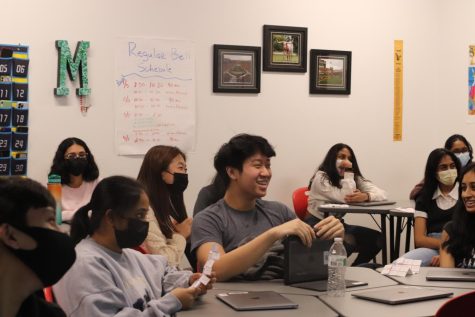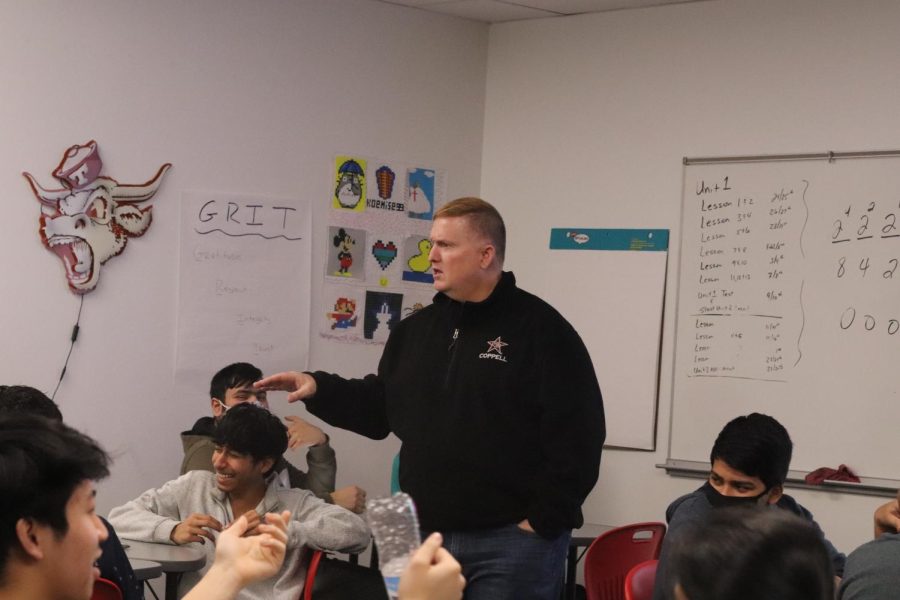Classroom discussions need you
Coppell High School AP computer science teacher Michael McCabe engages his students in group discussion. The Sidekick staff designer Esther Kim thinks classroom discussions require involvement from all sides of the room.
February 8, 2022
An uncomfortable silence falls over the classroom when a teacher asks their class for their opinion on a topic. Students squirm in their chairs; no one is willing to contribute to the open discussion. After a long minute, the teacher sighs and picks a student, who reluctantly mumbles a poorly constructed answer. The teacher sighs and continues the lesson without any other attempts at a conversation.
Recovering from last year and online learning, teachers have noticed that students engage less in classroom discussions compared to the years before. I myself have noticed that a lot of my teachers reverted back to lecture based education, because students do not respond and discussions fall limp.
A group discussion, according to the Merriam-Webster dictionary, is “a discussion involving a number of people who are connected by some shared activity, interest or quality.” Group discussions are an important activity in academic and business settings, as they allow people involved to exchange ideas and communicate with each other. Just like in any relationship, communication is key in a classroom, as discussion establishes a sense of understanding between a group of people.

Coppell High School computer science teacher Michael McCabe thinks discussions rely on the open environment of the classroom, and that students should have a trusting relationship with their teacher and classmates. His class discussions start in small groups, generally beginning with a question to get the students to know their group. Simple questions like, “tell your group about your weekend” allow students to open up a bit more with their peers. After icebreakers, the students discuss the lesson topic in their small groups. In the end, the discussion moves to the entire class.
“It’s like a pebble in the water,” McCabe said. “You throw a pebble in the water and that’s your circle. As time goes by, the circle gets bigger. Eventually, we’re at a circle that includes the whole class.”
As a current sophomore, entering my freshman year online was difficult, especially with my short attention span. Watching 30-minute lecture and taking notes was almost impossible, so I found classes where I could interact with my teachers and classmates very enjoyable. Although it was tiring at times to sit in a Zoom for hours, talking through a geometry problem with my classmates was much more preferable than trying to understand what cultural patterns were through Google Slides or a video lecture.
It’s like a pebble in the water. You throw a pebble in the water and that’s your circle. As time goes by, the circle gets bigger. Eventually, we’re at a circle that includes the whole class.
— Michael McCabe
Last year, many of my teachers strayed away from group projects, but my French teacher, Fabienne Morel, required us to be in breakout rooms on Zoom and converse in the language. There were many times when I faced a blank profile picture, or someone whose microphone was broken. One time, my partner left the Zoom entirely, leaving me to explain my unfortunate situation to the teacher.
Mutual respect is key.
Speak to your classmates. Tell them about your favorite food, what you did over the weekend or about a book you like. Don’t be afraid to ask questions. Trust that no one will judge you. If they do, so what?
Fill the empty silence with a comment.
The discussion depends on you.
Follow Esther Kim (@yk_estherr_) and @CHSCampusNews on Twitter.











